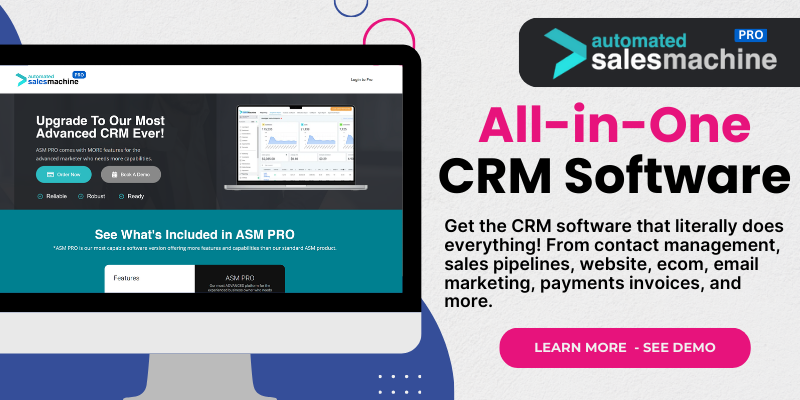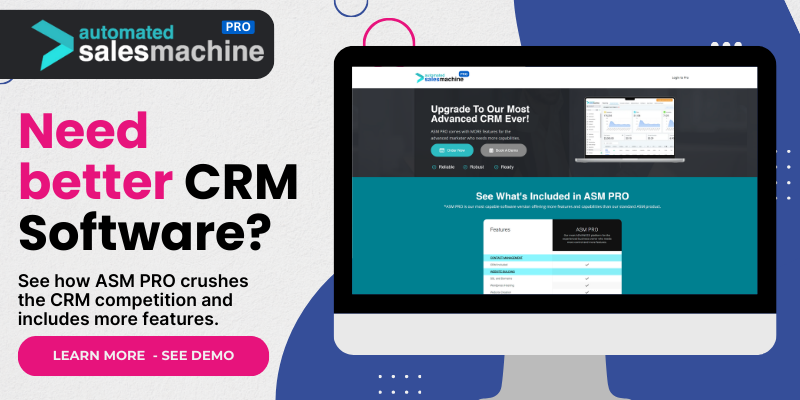1. Understanding Your Business Needs
Assess Your Current Processes
Before diving into any CRM software, like Roboeyelabs, it’s crucial to take a step back and assess your current operations. What are your pain points? What processes are bogging you down? For me, recognizing these things helped me focus on what’s really necessary. If your team is struggling with task management or lead tracking, these are red flags that a CRM might be just the ticket.
Take a close look at your workflow. Are you still using spreadsheets and emails to manage customer relations? This could lead to missed follow-ups and lost opportunities. A CRM can streamline processes and keep everything organized, but only if you know what you need it for.
Engage your team in this conversation. I often find that my staff have insights that can highlight gaps in our systems. By understanding what everyone needs, I can tailor the CRM setup to serve us all better, ensuring no one’s preferences go overlooked.
Identify Key Features You Need
Once you know your business needs, the next step is to identify the key features that can enhance your operations. Roboeyelabs offers a myriads of functionalities, but do you need all of them? My experience taught me to prioritize essentials like automated reminders, tracking customer interactions, and reporting tools for insights.
Aside from the basics, think about integration with other tools you’re using. I realized that my team spends a lot of time switching between applications. Finding a CRM that integrates seamlessly with those tools can save precious time and boost productivity.
Remember, it’s easy to get swayed by flashy features. Stick to what genuinely enhances your daily operations. If you value automation, ensure the CRM can deliver that efficiently, and not just in theory.
Budget Considerations
Let’s be real: budgets are a significant factor. As a business owner, I always assess how much I’m willing to invest without breaking the bank. Roboeyelabs offers different packages, so it’s vital to explore these options thoroughly. Remember, choosing the cheapest option might end up costing you more in the long run when features are lacking.
Evaluate not just the sticker price, but potential ROI. Will implementing Roboeyelabs save you manpower or lead to increased sales? It’s critical to look at the bigger picture. In my experience, getting quotes and possibly negotiating with the provider can lead to some beneficial deals.
And don’t forget to factor in training costs and implementation time! Sometimes, what looks like a great deal can hit hard when you realize the hidden expenses involved in adopting the software.
2. User Experience and Training
Intuitive Design
Next up is user experience, an often overlooked but majorly impactful area. If a software is difficult to navigate, your team will resist using it. I’ve worked with platforms that were more complicated than a Rubik’s cube—frustrating for everyone involved. Roboeyelabs has a pretty intuitive design that I found welcoming for new users.
Pay attention to usability. Can your team learn it quickly? A good CRM should streamline processes, not complicate them further. I suggest testing it out during free trials if available to see if your staff feels comfortable.
Don’t shy away from seeking out user reviews. I often check places like forums or social media groups for insights from actual users. Getting the real scoop can help avoid costly mistakes.
Training and Onboarding
Ah, training—the area that can make or break your CRM success. I’ve had experiences where we rushed through training and it backfired spectacularly. Planning out a comprehensive training program is essential if you want everyone on board and using Roboeyelabs to its full potential.
Consider organizing both group training and one-on-one sessions. Some team members might need a little more attention than others. Creating a supportive environment can help everyone get up to speed without feeling overwhelmed.
Moreover, make sure you’re considering ongoing support. Keeping a line open for questions long after the initial rollout can really help. I’ve found that regular check-ins and refresher sessions keep everyone from getting stagnant.
Feedback Mechanisms
Feedback is crucial when implementing any new tool. After adopting Roboeyelabs, I made it a point to regularly poll my team about their experiences. This level of communication has allowed us to refine our systems to better suit our evolving needs.
Create channels where your staff can voice their ideas or concerns regarding the CRM. This can not only enhance their buy-in but also bring forth innovative suggestions for utilizing the software effectively.
Asking for feedback after significant updates or changes can also help gauge how the platform is being accepted and used. Nobody likes an unresponsive tool, and consistent communication can ensure that Roboeyelabs is serving its purpose.
3. Scalability and Flexibility
Anticipating Growth
Every business aims to grow and expand. When exploring Roboeyelabs, I found it essential to consider whether the software can grow with me. I needed a platform that wouldn’t become obsolete as my business scales. Getting locked into software that doesn’t adapt can cripple progress.
Evaluate the limitations of the plans offered. Can you upgrade smoothly as your customer base increases? Don’t settle for options that offer no flexibility in capacity or features as your needs evolve.
Look to see if Roboeyelabs includes features that support scalability, such as additional data storage, advanced analytics, and extensive customer support. These elements can make a big difference as your operations grow.
Customizable Options
Customization is another aspect I value highly. Does Roboeyelabs allow you to tailor the software to your business processes? If a product is rigid, you might end up customizing your business around the software instead of the other way around.
Check for options like custom fields, dashboards, and reports that can be tailored to reflect your business’s choices and priorities. I’ve personally found that having the ability to tweak things to my liking boosts user engagement significantly.
Engage your team when assessing these customizable options. Their input is vital in creating a system that resonates with everyone involved, ensuring that the CRM feels less like a chore and more like a tool for growth.
Modifications During Change
As a business changes, so do its needs. It’s reassuring to know that the CRM I choose can be modified over time. Whether that means adding new features or reconfiguring existing ones to adapt to market changes, flexibility is key.
Ensure that you assess how easy it is to implement changes. I’d advise testing out changes in feature settings or workflows during your evaluation phase if possible—just to see how seamless the adjustments are.
Staying nimble allows your team to respond to new challenges in your market without getting bogged down by software limitations. The worst feeling is knowing you’re hemorrhaging productivity simply because your CRM isn’t accommodating your evolving needs.
4. Customer Support & Community
Quality of Customer Service
Ever had a technical glitch that you needed help with? Yeah, I have too. Having great customer support when using Roboeyelabs is paramount. I can’t stress enough how frustrating it is to spend hours looking for solutions when a simple call could have resolved everything.
Investigate what type of customer support is available. Is it 24/7? Can you reach them via phone, chat, or email? My found that I appreciate the versatility in contacting support, especially when deadlines loom. There’s nothing worse than being stuck!
Also, consider response times. Quick responses can make the difference between addressing an issue right away or getting lost in technical limbo. Don’t hesitate to ask about this upfront when assessing vendors.
User Community and Resources
A strong user community can be a game changer. I’ve often turned to forums or user groups for help or hacks that I didn’t know about. It’s comforting to know there are others out there navigating the same software challenges.
Explore whether Roboeyelabs has an active user community. An active forum or user group can foster learning and sharing of best practices. I’ve learned a ton just by bouncing ideas off fellow users.
Additionally, access to tutorials, webinars, and documentation can be incredibly beneficial. Having a wealth of resources at your fingertips ensures your team can unravel the full potential of the software.
Regular Updates and Improvements
Tech is always changing, and it’s vital for any CRM software to keep up. I appreciate knowing that Roboeyelabs invests in regular updates to enhance user experience. This keeps the software functioning optimally and ensures that the tools I need are always evolving.
Ask about their update frequency and how they integrate user feedback into their development cycle. Hearing that they actively seek input from users makes me feel valued as a customer, and it often leads to improvements that enhance my user experience.
Documentation on updates can also keep your team informed of new features or improvements. Sending out newsletters each time an update comes can help everyone stay in the loop!
5. Integration with Current Tools
Seamless Integrations
If you’re like me, you probably have a bunch of tools you rely on every day. When looking at Roboeyelabs, one key aspect for me was how well it integrates with existing software. The easier these systems can communicate, the less time I waste juggling platforms.
I checked compatibility with tools like my email system, project management software, and eCommerce platforms. A robust CRM should integrate easily, and it was comforting to see Roboeyelabs promises so many integrations already in place.
Don’t just go by the sales pitch; try to get real-world testimonials on integration experiences. Hearing from peers can save you from unforeseen headaches later on.
APIs and Custom Integration Options
In addition to built-in integrations, I wanted to know if Roboeyelabs offered robust API options. Custom integrations can be incredibly valuable and allow you to connect the CRM with niche tools tailored to your specific industry needs.
Make sure to understand the technical support available for setting up these integrations. A user-friendly API can empower you to extend the functionality of your CRM, but without support, it might end up being more trouble than it’s worth.
Consider how your integration setup might change as you grow. Flexibility in APIs can make a world of difference for future developments.
Impact on Workflow
Ultimately, it’s not just about whether Roboeyelabs can integrate with your tools; it’s about how these integrations affect your workflow. I found immense value in systems that allowed data to flow seamlessly, which reduced that annoying task of double-entry.
Stay mindful of which integrations can lead to improvements. Ask yourself: How is this tool making my life easier? A well-integrated CRM can be a catalyst for exceptional efficiency, something every consultant and small business owner hotly pursues.
The goal is to create a seamless experience for your team. Pay attention to how these tools interact to ensure they complement each other rather than cause friction.
Frequently Asked Questions
1. What is Roboeyelabs CRM Software?
Roboeyelabs CRM Software is a customer relationship management tool designed to help businesses streamline their processes, manage customer interactions, and enhance overall efficiency.
2. How can I determine if Roboeyelabs is right for my business?
To determine if Roboeyelabs is right for your business, assess your processes, identify key features you need, and consider your budget and scalability. It’s also essential to think about user experience and support options.
3. What features should I look for in a CRM?
Look for features like automation capabilities, reporting tools, integration with existing software, and user-friendly interfaces. Customizability can also significantly enhance your productivity.
4. Is training necessary for using Roboeyelabs?
Yes, training can significantly boost your team’s proficiency with Roboeyelabs. Implementing a well-structured training program can help ensure that your team fully utilizes its features.
5. How does integration affect the use of CRM software?
Integration allows for seamless data flow between tools, reducing manual entry and improving accuracy. A well-integrated CRM can streamline workflows and greatly enhance efficiency.

